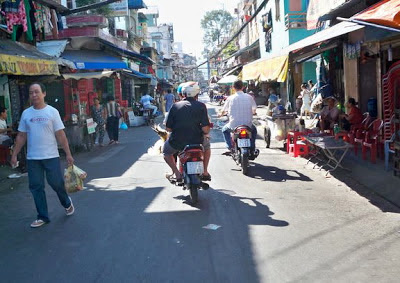 |
| Kevin and Drew were our first overnight guests! |
 |
| Cocktail time with Heather at the aptartment |
Yes Elizabeth, there is basketball in HCMC. The SSA Saigon Heat is the first ever international pro basketball team to represent Vietnam. I'm told the team is decent am I'm hoping to attend a game. Sadly, no hockey.
HCMC is the largest city in Vietnam, with a population of about 7 million (plus a few tourists like those at left!). 93% of the city's inhabitants are ethnic Vietnamese. The next largest group is Chinese (6 %). Cholon, or District 5 in HCMC, is home to the largest Chinese community in Vietnam.
The City is divided into 24 Administrative Districts, which are both urban and rural. We live in District 7, which is part of the new South Saigon Urban development. The majority of the tourist spots are found in District 1, which still has wide, elegant boulevards (packed with scooters) and many French colonial buildings. There is also an 'unofficial' backpackers district located within District 1 which is known for its affordable accommodation, cheap clothes (great knock-offs), souvenirs etc. A decent room in a hostel can be had for as little as $6 per night.
I was told by a Vietnamese guide on one of our tours that the city has 2 seasons: the hot season and the rainy season. The beginning of the rainy season coincides with my return to Canada at the beginning of May!
 |
| Paul and Randy (view towards our kitchen). |
 |
Continental Hotel, colonial French building famously
frequented by visitors like Walter Cronkite, Somerset
Maugham and Graham Greene, author of the Quiet American.
|
 |
| The traffic circle outside the Ben Thanh market. |
 |
Outside the War Remnants Museum - a very graphic portrayal
of the American War. Many disturbing images, particularly
of the after-effects of the use of the defoliant Agent Orange. |
HCMC was originally a Khmer (Cambodian)
trading post called Prey Nokor. It was conquered by the French in 1959 and influences on the city's infrastructure and architecture can still be seen in the city today. During French
colonial occupation, it was the capital of Cochinchina and known as Saigon. When the French were defeated at the battle of Dien Bien Phu and subsequently French troops were withdrawn from the North and the Viet Minh from the south, Saigon became the capital of the Republic of Vietnam (1955 - 1975). In July 1976, the Communist government, after having defeated the U. S., renamed the city, Ho Chi Minh, after their much admired leader, although Saigon is still commonly used.
 |
Heather, Randy and my young friend Nhi, who acted as our
guide, upstairs at the Rex Hotel, famous for the 'five o'clock
follies' during the American War. |
 |
| On the way to Ben Thanh. |
 |
| Heather outside the General Post Office. |
The Ben Thanh Market is a very recognizable landmark and the spot I use as a drop off/pick up point for taxi drivers. It is an easy walk to the other sites from there. It was built by the French in 1914 and is a covered concrete building of enormous size. You can get anything at this market from fresh produce, clothing, jewellry, spices, souvenirs to livestock and hardware. Prices are cheap but bargaining is necessary.
 |
| Heather, Randy and I - perpetual Spring! |
I think my favourite building in the city is the General Post office. It was designed by a French architect in the late 1800's and it reminds me of Union Station. I'm told the architect, Gustave Eiffel, modeled it after Gare de l'est in Paris. It represents gothic, renaissance and French influences.
 |
Randy, Paul, Heather before dinner at Cham Charm, Phu
My Hung. |
 |
| The Municipal Theatre, AKA the Opera House. |
 |
| Phu My Hung sunset (from our 4th floor apt.) |
Cham Charm is a great buffet style restaurant in Phu My Hung. It's Cham heritage is reflected in the architecture and the food. The Cham people are an ethnic group found mainly in Cambodia, Loas and Vietnam. They are thought to be the remnant population of the Kingdom of Champa and their culture has been profoundly influenced by Indian culture. Small groups of both Muslim and Hindu Cham people can be found in HCMC.
The Municipal Theatre, or as it is more commonly known, the Opera House is a beautiful French colonial building built in 1899 as a concert hall for the French. it was used briefly as the headquarters of the South Vietnamese National Assembly in 1956. It is used today for performances that include everything from traditional Vietnamese theater and classical Western music to rock concerts and gymnastics.















































